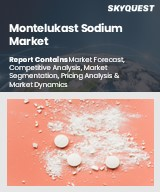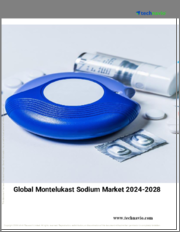
|
시장보고서
상품코드
1517645
몬테루카스트 나트륨 시장 : 제품 유형별, 제형별, 용도별, 유통 채널별 - 세계 예측(2024-2032년)Montelukast Sodium Market - By Product Type (Montelukast Sodium Amorphous, Montelukast Sodium Crystalline) Dosage Form (Tablets, Oral Solutions), Application (Asthma, Allergic Rhinitis, Urticaria), Distribution Channel - Global Forecast (2024 - 2032) |
||||||
몬테루카스트 나트륨 시장 규모는 세계의 천식 및 알레르기성 비염 등 호흡기질환의 유병률 상승을 배경으로 2024-2032년 11.4%의 CAGR을 기록할 것으로 추정되고 있습니다.
미국 국립보건원에 따르면 전 세계에서 약 4억 명이 알레르기성 비염을 앓고 있다고 합니다.
공해 증가와 생활습관의 변화로 인해 호흡기 질환을 개선하기 위한 호흡기 약물의 사용이 증가하고 있습니다. 또한 COPD 및 기관지염과 같은 호흡기 질환 치료제로서 연구자들이 새로운 용도를 발견하고 있으며, 이는 제품 수요 증가로 이어지고 있습니다. 제약회사와 연구기관의 협력 관계도 시장 성장의 원동력이 되고 있습니다.
몬텔카스트 나트륨 산업은 제품 유형, 제형, 용도, 유통 채널 및 지역으로 구분됩니다.
제형별로는 경구제 시장 규모는 2032년까지 편의성, 복용의 용이성, 환자의 순응도 향상으로 인해 큰 폭의 성장이 예상됩니다. 환자 중심의 헬스케어에서는 정제나 과립제의 대안으로 경구용 액제가 주목받고 있으며, 특히 소아나 노인의 경우 삼키기 어려운 환자들에게 정확한 용량 관리가 가능하다는 장점이 있습니다. 또한 경구용 제제는 기호성이 우수하여 환자의 수용성과 순응도를 향상시킬 수 있습니다.
알레르기성 비염 치료제인 몬테루카스트 나트륨 산업은 호흡기 질환과 관련된 증상을 관리하는 데 있으며, 약물의 효율성에 힘입어 2024-2032년 사이에 주목할 만한 매출을 창출할 것으로 예상됩니다. 알레르기성 비염은 코막힘, 재채기, 가려운 눈 등의 증상을 유발하는 흔한 질환입니다. 따라서 몬테루카스트 나트륨은 류코트리엔을 표적으로 삼아 증상을 완화하고 환자의 호흡기 건강을 개선하는 데 사용됩니다.
아시아태평양의 몬테루카스트 나트륨 산업은 환경오염, 생활습관의 변화, 유전적 소인으로 인한 호흡기 질환의 유병률 증가로 인해 2032년까지 큰 성장률을 보일 것으로 예상됩니다. 아시아에서는 도시의 성장과 산업 확대로 인해 대기 질이 악화되고 있습니다. 건강 인프라 개선과 의약품 접근성 확대에 대한 정부 지원 증가도 이 지역 시장 성장을 가속할 것으로 보입니다.
목차
제1장 조사 방법과 조사 범위
제2장 개요
제3장 업계 인사이트
- 에코시스템 분석
- 업계에 대한 영향요인
- 촉진요인
- 호흡기질환의 증가
- 약물전달의 진보
- 의식의 향상으로 진단
- 업계의 잠재적 리스크 & 과제
- 부작용과 안전성에 대한 우려
- 대체 치료 선택사항
- 촉진요인
- 성장 가능성 분석
- 규제 상황
- Porter의 산업 분석
- PESTEL 분석
제4장 경쟁 구도
- 서론
- 기업 점유율 분석
- 경쟁 포지셔닝 매트릭스
- 전략 전망 매트릭스
제5장 시장 추산·예측 : 제품 유형별, 2021-2032년
- 주요 동향
- 비정질 몬테루카스트 나트륨
- 몬테루카스트 나트륨 결정
제6장 시장 추산·예측 : 제형별, 2021-2032년
- 주요 동향
- 정제
- 구강 액제
제7장 시장 추산·예측 : 용도별, 2021-2032년
- 주요 동향
- 천식
- 알레르기성 비염
- 두드러기
- 기타 용도
제8장 시장 추산·예측 : 유통 채널별, 2021-2032년
- 주요 동향
- 병원 약국
- 소매 약국
- 온라인 약국
제9장 시장 추산·예측 : 지역별, 2021-2032년
- 주요 동향
- 북미
- 미국
- 캐나다
- 유럽
- 독일
- 영국
- 프랑스
- 스페인
- 이탈리아
- 네덜란드
- 기타 유럽
- 아시아태평양
- 일본
- 중국
- 인도
- 호주
- 한국
- 기타 아시아태평양
- 라틴아메리카
- 브라질
- 멕시코
- 아르헨티나
- 기타 라틴아메리카
- 중동 및 아프리카
- 사우디아라비아
- 남아프리카공화국
- 아랍에미리트
- 기타 중동 및 아프리카
제10장 기업 개요
- Apotex Inc.
- Cipla Limited
- Dr. Reddy's Laboratories Ltd.
- Intas Pharmaceuticals Ltd
- Merck & Co., Inc.
- Morepen Laboratories Limited
- Mylan N.V.
- Sandoz AG
- Sanofi
- Sun Pharma Industries Limited.
- Teva Pharmaceutical Industries Limited
Montelukast sodium market size is estimated to register 11.4% CAGR between 2024 and 2032, backed by the rising prevalence of respiratory diseases, such as asthma and allergic rhinitis worldwide. As per the National Institute of Health, around 400 million people globally are affected with allergic rhinitis worldwide.
Increased pollution and changing lifestyles are leading to the increased use of respiratory medications to improve symptoms. Moreover, researchers are uncovering new uses for drugs in treating respiratory diseases likes COPD and bronchitis, leading to increased product demand. Collaborations between pharmaceutical companies and research institutes are also driving the market growth.
The montelukast sodium industry is segmented into product type, dosage form, application, distribution channel and region.
With respect to dosage form, the market size from the oral solutions segment is anticipated to witness substantial growth through 2032, owing to their convenience, ease of administration, and enhanced patient compliance. Patient-centered healthcare is emphasizing oral solutions as an alternative to tablets or granules, particularly for children and the elderly for offering precise dose control for those who have difficulty swallowing. Oral solutions also provide better taste as well as increased patient acceptance and compliance in healthcare settings.
Montelukast sodium industry from the allergic rhinitis application segment will generate notable revenue during 2024-2032, backed by the efficiency of drugs in managing symptoms related to respiratory conditions. Allergic rhinitis is a common condition causing symptoms like nasal congestion, sneezing, and itchy eyes. To that end, montelukast sodium is used as it targets leukotrienes to relieve symptoms and improve respiratory health for sufferers.
Asia Pacific montelukast sodium industry is slated to witness a significant growth rate through 2032, attributed to the rising prevalence of respiratory diseases due to environmental pollution, changing lifestyles, and genetic predispositions. Urban growth and industrial expansion in Asia are deteriorating air quality. The growing government support for improving health infrastructure and expanding access to medication will also stimulate the regional market growth.
Table of Contents
Chapter 1 Methodology & Scope
- 1.1 Market scope & definitions
- 1.2 Research design
- 1.2.1 Research approach
- 1.2.2 Data collection methods
- 1.3 Base estimates & calculations
- 1.3.1 Base year calculation
- 1.3.2 Key trends for market estimation
- 1.4 Forecast model
- 1.5 Primary research and validation
- 1.5.1 Primary sources
- 1.5.2 Data mining sources
Chapter 2 Executive Summary
- 2.1 Industry 360-degree synopsis
Chapter 3 Industry Insights
- 3.1 Industry ecosystem analysis
- 3.2 Industry impact forces
- 3.2.1 Growth drivers
- 3.2.1.1 Increasing prevalence of respiratory diseases
- 3.2.1.2 Advancements in drug delivery
- 3.2.1.3 Growing awareness and diagnosis
- 3.2.2 Industry pitfalls & challenges
- 3.2.2.1 Side effects and safety concerns
- 3.2.2.2 Alternative treatment options
- 3.2.1 Growth drivers
- 3.3 Growth potential analysis
- 3.4 Regulatory landscape
- 3.5 Porter's analysis
- 3.6 Pestel analysis
Chapter 4 Competitive Landscape, 2023
- 4.1 Introduction
- 4.2 Company market share analysis
- 4.3 Competitive positioning matrix
- 4.4 Strategy outlook matrix
Chapter 5 Market Estimates and Forecast, By Product Type, 2021 - 2032 ($ Mn)
- 5.1 Key trends
- 5.2 Montelukast sodium amorphous
- 5.3 Montelukast sodium crystalline
Chapter 6 Market Estimates and Forecast, By Dosage Form, 2021 - 2032 ($ Mn)
- 6.1 Key trends
- 6.2 Tablets
- 6.3 Oral solutions
Chapter 7 Market Estimates and Forecast, By Application, 2021 - 2032 ($ Mn)
- 7.1 Key trends
- 7.2 Asthma
- 7.3 Allergic rhinitis
- 7.4 Urticaria
- 7.5 Other applications
Chapter 8 Market Estimates and Forecast, By Distribution Channel, 2021 - 2032 ($ Mn)
- 8.1 Key trends
- 8.2 Hospital pharmacies
- 8.3 Retail pharmacies
- 8.4 Online pharmacies
Chapter 9 Market Estimates and Forecast, By Region, 2021 - 2032 ($ Mn)
- 9.1 Key trends
- 9.2 North America
- 9.2.1 U.S.
- 9.2.2 Canada
- 9.3 Europe
- 9.3.1 Germany
- 9.3.2 UK
- 9.3.3 France
- 9.3.4 Spain
- 9.3.5 Italy
- 9.3.6 Netherlands
- 9.3.7 Rest of Europe
- 9.4 Asia Pacific
- 9.4.1 Japan
- 9.4.2 China
- 9.4.3 India
- 9.4.4 Australia
- 9.4.5 South Korea
- 9.4.6 Rest of Asia Pacific
- 9.5 Latin America
- 9.5.1 Brazil
- 9.5.2 Mexico
- 9.5.3 Argentina
- 9.5.4 Rest of Latin America
- 9.6 Middle East And Africa
- 9.6.1 Saudi Arabia
- 9.6.2 South Africa
- 9.6.3 UAE
- 9.6.4 Rest of Middle East and Africa
Chapter 10 Company Profiles
- 10.1 Apotex Inc.
- 10.2 Cipla Limited
- 10.3 Dr. Reddy's Laboratories Ltd.
- 10.4 Intas Pharmaceuticals Ltd
- 10.5 Merck & Co., Inc.
- 10.6 Morepen Laboratories Limited
- 10.7 Mylan N.V.
- 10.8 Sandoz AG
- 10.9 Sanofi
- 10.10 Sun Pharma Industries Limited.
- 10.11 Teva Pharmaceutical Industries Limited















